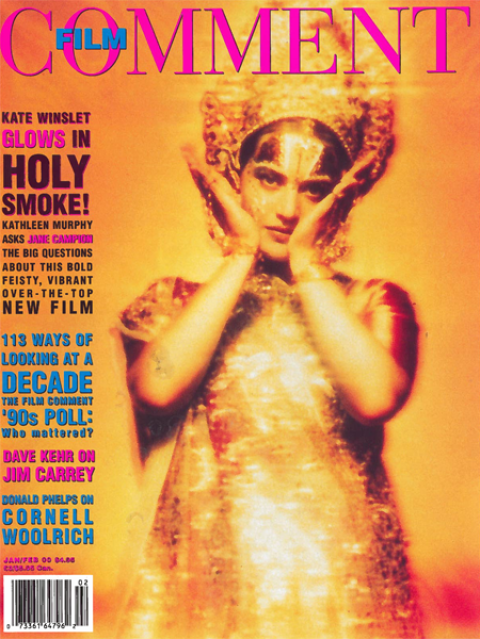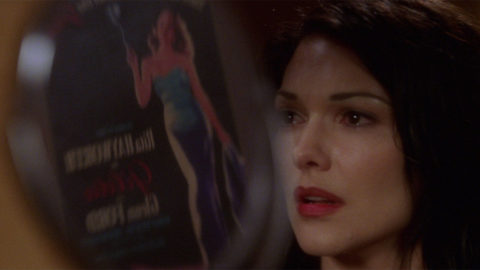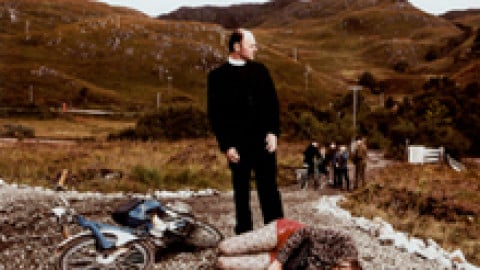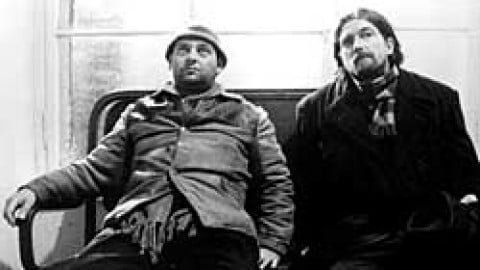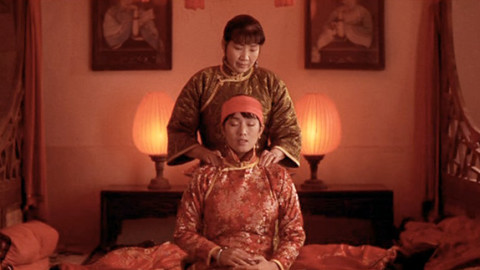This past fall, the editors, staff, and some friends of this magazine sent out letters to a blue-ribbon panel of critics, filmmakers, authors; archivists—people with a serious personal and professional investment in film -inviting their selections of the film of the decade and the film person of the decade. We weren’t necessarily after the “greatest” film, “most creative director,” or “brightest star.” Rather, we asked, “Zero in on the film of the Nineties, from any nation, that casts the longest shadow for you, whether in terms of excellence, power, visionary quality, symbolic importance, influence, or epically destructive badness—this is entirely your call. Same with the individual who, for better or worse, most decisively defines film in the Nineties. And we’d appreciate a brief statement why.” Additionally, we suggested that they send their lists of the Ten Best films of the decade, or the Ten Most Underrated. That part was optional, but as it turned out, most respondents gave it a whirl, and very provocatively, too.
ANDREW SARRIS film critic, New York Observer
Bill Murray transcended his Saturday Night Live beginnings by rejuvenating American screen comedy with many wry, but never sick or mean-spirited, twists, most notably in the American comedy of the decade, Groundhog Day.
TADAO SATO film scholar, Japan
Color of Paradise (1999, Iran)—This is one of the noblest films ever made.
Hayao Miyazake—a leading Japanese animation filmmaker.
Films (chronological): The Dispossessed (Aravindan, India), Kae Byok (Im Kwon-Taek, Korea), Nostalgia for the Countryland (Nhat Minh Dang, Vietnam), Dukhai (Bangladesh), The Sleeping Man (Kohei Oguri, Japan), Red Persimmon (Wang Tung, Taiwan), Ferocious Saint Lord of Gobi (Mongolia), The Teacher of Cyrill Alphabet (Mongolia), The Wind Will Carry Us (Iran), Fatherless (Yoshihisa Shigeno, Japan)
PETER SCARLET San Francisco Film Festival
Sorry to be such a late entry, but I’m in Turin and my reference materials here are nonexistent. So I’ll rely on memory to select not one film or one person, but those who kept it “cherce” during a decade when many too many people made many too many films: Victor Erice, Alexei Guerman, and Terence Malick made one jewel apiece, while Alain Cavalier, Hou Hsiao-hsien, Otar Iosseliani, Ken Jacobs, Abbas Kiarostami, Chris Marker, Nanni Moretti, and Straub-Huillet were slightly more prolific but just as good. Then there was the amazing Manoel de Oliveira, the last active survivor of the silent era, who nonetheless made more good films than just about anyone else in the Nineties. If we’re lucky he’ll keep on going well into the next century.
BARBARA SCHARRES director, Chicago Film Center
A Brighter Summer Day (4-hour version), Edward Yang—A film that transforms narrative through its deeply personal sense of observation, and grips the emotions and imagination with its steadfast power.
John Woo and Terence Chang—This director-producer combination opened the American film industry to an influx of Hong Kong talent and achieved the near-impossible, the ensconcing of a previously obscure (to American audiences) Asian director on Hollywood’s “most powerful” lists. For better or for worse, Woo’s style has impacted everything from the action genre to TV commercials to student films worldwide.
Most Underrated (no particular order): Another Lonely Hitman (Rokuro Mochizuki), A Brighter Summer Day, Breaking the Waves, Bullet in the Head (Woo), The Eel, Flowers of Shanghai, Keep Cool, King of New York, The Letter (Oliviera), The Wind Will Carry Us
RICHARD SCHICKEL film critic, Time / author / filmmaker
Fargo—for its weird, hilarious, curiously moving blend of postmodern narrative hubbub, resolved with an application of simple, traditional morality.
Steven Spielberg—for mastering the art of making morally intelligent, emotionally riveting, superbly realized movies that are (deservedly) great popular successes, and for using his immense power within the industry conscientiously and judiciously.
Ten Best: I don’t know if they’re the “best,” but they continue to tug at my mind. Alphabetically: Bullets Over Broadway, Fargo, Groundhog Day, L.A. Confidential, Live Flesh, Pulp Fiction, Saving Private Ryan, Schindler’s List, True Romance (Tony Scott), Unforgiven
PAUL SCHRADER screenwriter-director
Mother and Son (Sokurov)—for keeping the faith.
Quentin Tarantino—signpost of the decade.
Best of the Nineties: Flowers of Shanghai, Mother and Son, GoodFellas, Boys Don’t Cry, Fearless, Romeo + Juliet (Luhrmann), Get Shorty (Sonnenfeld), Secrets & Lies, Maborosi, My Own Private Idaho, Light Sleeper, Richard III
DAVID SCHWARTZ American Museum of the Moving Image
Forrest Gump—A year after Jurassic Park used digital dinosaurs to usher in the cinema’s computer age, Forrest Gump literally made history with a plot based on virtual reality. Encapsulating the traumas of the past four decades as Clinton-era allegory, Gump summarized past and present while foretelling a future where the lines between history and fantasy, photographic reality and artificial imagery, were blurred: entertainment as history and vice versa.
Harvey Weinstein—The biggest movie stories of the Nineties were the marriage between Hollywood and Indiewood and the ascent of marketing, publicity, and hype as the driving forces of film culture (as opposed to film criticism and serious discussion about what is on the screen). Starting early in the decade with The Crying Game and continuing through the New York Yankees-style domination of the Oscars, Miramax’s Harvey Weinstein was easily the most influential person in the arena of the art film (which seems to be defined these days as movies made for anyone over the age of 20).
Ten Best (in order of preference): La Belle Noiseuse, Cold Water (Assayas), Dead Man, A Summer’s Tale (Rohmer), A Moment of Innocence, The Long Day Closes, Time Indefinite & Six O’Clock News (McElwee), Out of Sight, GoodFellas, Eyes Wide Shut
LISA SCHWARZBAUM film critic, Entertainment Weekly
Pulp Fiction—Quentin Tarantino’s audacious 1994 masterwork was the condition to which all independent filmmaking in the Nineties aspired. It cracked open the possibilities of indie art like a piñata, and in its vitality raised the performance standards of every actor appearing in it, none more rewardingly than John Travolta.
James Cameron—He went big, bigger, Titanically biggest in a decade where size, cost, and technical daredevilry broke records, and he faced down the studios nervously monitoring his epic when they wanted to reel him in. He’s the opposite of indie-man and his legacy is huge around the world: Now we’ve got big, expensive, millennium-sized Hollywood movies in his giant wake—most of them missing Cameron-sized filmmaking talent.
P. ADAMS SITNEY author / educator
Film of the Decade: Side /Walk/ Shuttle (1991) by Ernie Gehr
Filmmaker of the Decade: Robert Beavers, who has revised and exhibited widely, in this decade, his astonishing films of the past thirty years; and he has made available the work of Gregory Markopoulos (1928-1992), thus restoring to public view two central oeuvres.
ROBERT SKLAR author / educator
The Puppetmaster—The great historical film of the decade, touching on nation and colony, freedom and subjection, private and public, art and politics, actuality and fiction. It demonstrates, above all, a style of narrating the past in cinema so as to show its loss, yet also survival, in the present.
Hou Hsiao-hsien—Not only because he is arguably the decade’s most important filmmaker, but also because, to the shame of U.S. film culture, his films have almost entirely failed to receive commercial distribution here.
Ten Best (chronological): GoodFellas, Calendar, Guelwaar (Sembene), The Story of Qiu Ju, The Puppetmaster, Valley of Abraham, Cold Water, Through the Olive Trees, La Promesse, Mother and Son
GAVIN SMITH associate editor, Film Comment
Histoire(s) du cinéma by Jean-Luc Godard—The film of the decade was a video and a repeatedly revised work-in-progress: it brought together the rapture of an artform and the rupture of a century, reconciling and reaffirming cinema’s profanity and lyricism, and its materiality and mystery, while holding representation and spectacle never less than accountable to the betrayals of history.
Ask me another day and Person of the Decade could be Hou Hsiao-hsien, Abbas Kiarostami, Wong Kar-wai, or Sadie Benning, but today it’s Martin Scorsese: he made some of the decade’s very best films—GoodFellas, Kundun—and some of its most underrated—Cape Fear, Age of Innocence—and in Casino, a film that belonged equally to each category. Nobody worked harder, showed more devotion, gave more back. His body of work will not be denied.
Ten Best: A (Luther Price), Bad Lieutenant, Close-Up, Flat Is Beautiful / It Wasn’t Love (S. Benning), Goodbye South, Goodbye / Flowers of Shanghai, Irma Vep, Naked, The Thin Red Line, Tribulation ‘99: Alien Anomalies Under America (Baldwin), Triste + Variations (Nathaniel Dorsky)
Ten Most Underrated: The Birth of Love (Garrel), The Flower of My Secret (Almodóvar), From the East, Le Garçu; Khroustaliov, My Car!; Mars Attacks!, Natural Born Killers / JFK / Nixon, Point Break / Strange Days, Les Voleurs, To Sleep with Anger, Psycho
GREGORY SOLMAN film critic, DVD Express
The Blair Witch Project: Though undeserved successes always call to question the value of the greatest filmmakers’ labor to improve the art form, this is the first one so amateurish as to call to question the value of moviedom’s worst hacks—and its youth audience of indiscriminate sheep. A hundred years into cinema and it’s still, in an authentically frightening sense, a cheap carny attraction—deceptively shilled and wildly subject to the vicissitudes of fad and fashion. What was the point of Renoir, you ask? What was the point of Romero!
Steven Spielberg: Not since Victor Fleming’s 1939 has a filmmaker expressed such emotional intelligence and ingenious dexterity as Spielberg’s ‘93 (Schindler’s List and Jurassic Park) and ‘97 (Amistad and The Lost World). The director of Saving Private Ryan makes the movies be all that they can be.
Ten Most Underrated: Afterglow (Rudolph), The Age of Innocence, Amistad, The Big Lebowski (Coen), The End of Violence (Wenders), Geronimo: An American Legend (Hill), The Godfather Part III, Mars Attacks!, The Sheltering Sky (Bertolucci), Texasville (Bogdanovich)
MICHAEL SRAGOW film critic, Salon
Three Kings—One reason per king: It’s the peak example of an indie sensibility energizing big-audience storytelling; it both looks back to the late Sixties of How I Won the War and The Wild Bunch and ahead to a wide-open future; and in a great, gritty film tradition it uses the art of the fabulist to illuminate an unreported reality (that of the Gulf War).
Richard Lester: For helping inspire filmmakers as different as David O. Russell, Steven Soderbergh, Danny Boyle, Stacy Cochran, and Michael Patrick Jann to renew narrative cinema with adventurous and unpredictable subjects, tones, and styles, as well as a full quotient of “felt life.”
Ten Most Underrated: Babe: Pig in the City, Before Sunrise (Linklater), Cobb (Shelton), Devil in a Blue Dress (Franklin), Henry and June (Kaufman), The Russia House (Schepisi), Vincent and Theo (Altman), Where the Heart Is, The Whole Wide World, Wild Bill
CHUCK STEPHENS film critic, SF Bay Guardian
Days of Being Wild (Wong Kar-wai)—Besides reinventing the rules of nostalgia, renewing a variety of possibilites for art direction, and announcing that visual phenomenon called Christopher Doyle, Wong Kar-wai’s Fassbinderian ode to absent mothers established a new high ground for East Asian art films, just as blithely as it savaged—with a fusillade of fractured gestures and dysfunctional jump cuts—Hong Kong cinema’s action obsessions. Dizzying violence only takes a second, but Leslie Cheung and Tony Leung’s attention to their hairdos could last all night.
Kim Ki-young—Well-known to thousands of South Korean film fans, but only hastily observed by a handful of cineastes elsewhere in the world, Kim’s luridly overdesigned, psychosexually deranged films were resurrected, to audiences’ stunned acclaim, at the Pusan International Film Festival in 1997—just weeks before the director was killed in a house fire. That cinema this visually astounding, thematically extreme, and spiritually compelling might be hiding under rocks all around the globe is exactly the sort of thing that keeps cinephilia alive.
Ten Most Underrated: Sátántangó, Tribulation 99 (Baldwin), Dead Man; No Fear, No Die; Twin Peaks: Fire Walk With Me, The Adjuster, Cyclo, Lessons in Darkness, The Power of Kangwon Province (Hong Sang-soo), Nadja (Almereyda)
DAVID STERRITT film critic, Christian Science Monitor
Safe (Todd Haynes)—An utterly original achievement that has the extremely rare virtue of being at once stimulating in its ideas, resonant in its plot and character development, incisive in its social and political critique, and innovative in its use of narrative-film conventions. Although the latter quality led many to misconstrue its messages, it represents the highest level of independent American filmmaking in the Nineties.
Spike Lee—None of his Nineties films has equaled the importance of his 1988 classic Do the Right Thing, but he has continued to take a zillion artistic and commercial risks while forging the most substantial and sustained career of any minority-group filmmaker in modern American cinema.
Ten Most Underrated (chronological): Ju Dou (Zhang), Nouvelle Vague, Stone (Sokurov), Household Saints (Nancy Savoca), Naked, Safe, Mother Night (Keith Gordon), Dead Man, Taste of Cherry, The Sweet Hereafter
JULIA SWEENEY actress / author / screenwriter / director
Just gonna say my Person is Richard LaGravenese—for this decade, my personal greatest inspiration. From The Fisher King to his stunning directorial debut Living Out Loud, he has articulately mined the complex personalities of his characters in continually unique and hilarious ways. His scripts are dramatic yet laced with intricate subtlety. Anyone who could take the banal book Bridges of Madison County and transform it, with such sensitivity, into a respectable and even sometimes brilliant screenplay is a genius.
AMY TAUBIN film critic, Village Voice
JLG/JLG (Jean-Luc Godard)—The greatest filmmaker of the second half of the century contemplates the end of cinema and his own death.
Figure of the decade: Hou Hsiao-hsien—With The Puppetmaster, Goodbye South, Goodbye, and Flowers of Shanghai he gave new life to narrative film. A close second is Wong Kar-wai with the more seductive Fallen Angels and Happy Together.
Ten Underrated Films: Portrait of a Lady, The Age of Innocence, Safe, Coming to Terms with Death (Pascale Ferran), I Can’t Sleep (Claire Denis), Outer and Inner Space (Warhol), White Dog (Fuller), Dead Man, To Sleep With Anger, Crash
BERTRAND TAVERNIER
filmmaker / critic / historian
It’s very difficult for a filmmaker to answer a survey like this. You can hurt people, friends, colleagues. You have to fight against your own ego: every filmmaker would love to have done the film of the decade. So I’ll answer only the last two questions.
1) Kiarostami. 2) The 66 French film directors who signed a statement, a manifesto praising the civil disobedience against the Jean Louis Debre law on immigration, saying they would disobey this law and would never inform the police when they knew an immigrant without legal papers.
Some films are very popular in their own country and ignored by the rest of the world. I picked some films that are, as far as I know, unknown or not known enough in North America: Céline (Jean-Claude Brisseau), À la vie, à la mort (Robert Guediguian), Memoires d’immigrés (Yamina Benguigui), The Quince Tree Sun (Erice), La Vie est immense et pleine de dangers (Denis Gherbrant), Bar des rails (Cédric Kahn), Le Fils du Requin (Agnès Merlet), Dis moi que je reve (Claude Mourieras), Sale comme un ange (Breillat), The Quiet Room (Rolf de Heer).
I’d like to add a tribute to Christine Pascal’s Zanzibar and Le Petit Prince a dit and an Italian film of 1985 released in France in the Nineties, Ainsi parlait Bellavista by Luciano de Crescenza.
STEPHEN TEO film critic, Hong Kong
Flowers of Shanghai (Hou Hsiao-hsien)—Enthralling film to end the decade; repeated viewings will only ensure its greatness.
Clint Eastwood—for his longevity, and unchallenged revisionism of genre and image. Ten Best: Flowers of Shanghai; Chungking Express, Unforgiven, The Blade, Running Out of Time (Johnnie To), Through the Olive Trees, Cold Water, Eternity and a Day, The Blue Kite, A Brighter Summer Day (complete version)
DALE THOMAJAN
Twelve Best of the Nineties: 1. Life Is Sweet (but not necessarily Beautiful); 2. Metropolitan; 3. Mystery Train; 4. Stolen Children (Il ladro di bambini); 5. Ruby in Paradise; 6. The Snapper; 7. Welcome to the Dollhouse; 8. Trust; 9. GoodFellas; 10. Jesus of Montreal; 11. The Last Seduction; 12. Men in Black
DAVID THOMSON author
Schindler’s List—in that it was, simultaneously, so exquisitely made and yet so helplessly vulgar. It was enough to convince anyone that narrative fiction had taken a disastrous turn with the motion picture.
Orson Welles—He was dead, of course, but several books, the attempted recovery of aborted projects, movies about him, and the unwavering place of film’s first film for Kane made him the dominant figure. And we knew already, from Kane, that everything starts with death.
MICHAEL TOLKIN screenwriter-director / novelist
Boogie Nights—It summed it all up, filmmaking and history, and it was about movies, and what they’ve become, or what they really are and probably should be, filthy and violent and emotional.
Bob & Harvey Weinstein Ten Movies (alphabetical): Boogie Nights, Breaking the Waves, Buena Vista Social Club (Wenders), Crash, In the Company of Men, A Passion in the Desert (Lavinia Currier), The Sixth Sense, A Tale of Winter, The Race (Iranian film about a boy who wins a pencil set?), There’s Something About Mary … and I’d like to put Third World Cop and The Celebration and Sling Blade and The Blair Witch Project in here, also Happiness, and Three Kings. For all that, the restored version of Nights of Cabiria gave me the feeling that the movies are a lost artform. I’ve been reading again.
SERGE TOUBIANA editor, Cahiers du cinéma
Unforgiven — This film, which is a philosophical Western about life and death, about rebirth, is the one that impressed me the most in recent years. It’s also a great film about space and about time—therefore, about the cinema.
Abbas Kiarostami—In the very particular context of Iran and the development of religious fundamentalism, the work of Kiarostami seems to be the most original aesthetic event of the decade. His view of the world is free, his mise-en-scène of a great purity, and all his films are profoundly human.
LEONARDO GARCÍA TSAO film critic, Mexico
The Blair Witch Project—Halfway between a home video and a minimalist exercise, this little quickie managed to turn a whole industry on its head. A new beginning for cinema or a dead end? Only time will tell.
Martin Scorsese—The only current filmmaker who has continued to direct great movies for over three decades, without compromising his passion. In that stretch he hasn’t made a single indifferent film, let alone a bad one.
Ten Best (alphabetical): The Age of Innocence, Bad Lieutenant, Un Coeur en Hiver, Chungking Express, Deep Crimson, Ermo (Zhou Xiaowen), Heat, Three Colors: Red, To Live, Unforgiven
KENNETH TURAN film critic, L.A. Times
Leolo — No film of the Nineties haunts me as this French-Canadian one does, for the brilliance of its treatment of childhood, for its sad lack of recognition, and for the death, in a small plane crash, of its director, the mercurial Jean-Claude Lauzon, before he could make another feature.
Mike Leigh—His four features in the Nineties, building on the wonderful work that came before, have redefined what we can expect from film, have raised the bar for the level of emotional power, insight, and sensitivity the medium is capable of.
Ten Most Underrated (chronological): Paris Is Burning (Livingston), The Waterdance (Jimenez & Steinberg), Black Harvest (Bob & Robin Anderson), Leolo, See How They Fall, This Boy’s Life, The Blue Kite, Lamerica, Land and Freedom, A Self-Made Hero
GIULIA D’AGNOLO VALLAN Venice Film Festival
Eyes Wide Shut / Crash—Two titles. Maybe not really defining of the decade as much as they are transforming experiences. Maybe I choose them because of what they were aiming to film, maybe because they were both so grossly vilified.
Hou Hsiao-hsien—The most original and vital cinema of the decade has come from the Far East. Among those filmmakers, I love Takeshi Kitano but Hou seems nevertheless the most complete, moving, and arrestingly beautiful of all.
PETER VON BAGH film historian, Finland
The Straight Story (David Lynch) and Abbas Kiarostami—In both cases, I feel how other films (their idea and their sense is in the air, and something secret connects them) are looming very near the ones I almost at random picked as “absolutes”.
Films on art: Pialat and Van Gogh, Erice and The Quince Tree Sun, Godard and Histoire(s) du cinéma, Cozarinsky and Le Violon de Rothschild, Marker and The Last Bolshevik…. Their feel connects to both of these answers.
ARMOND WHITE film critic, New York Press
Short Cuts—Altman’s Olympian survey of modern Los Angeles is also a personal epic. It views American crisis that starts in bedrooms and spreads to the streets, cutting wide and deep through the decade of denial.
Quentin Tarantino—For re-popularizing sarcasm, cruelty, racism as movie-buffdom, he is our Pandora. But remember: Pandora was an innocent.
Ten Most Underrated: Beloved (Demme), Amistad, Where the Heart Is; The Godfather, Part III; The Delta (Ira Sachs), Equinox (Rudolph), Little Buddha (Bertolucci), Kansas City, Hamsun, Election (Alexander Payne)
MICHAEL WILMINGTON film critic, Chicago Tribune
GoodFellas and Casino (Martin Scorsese)—Great late pinnacles of noir. Brilliant “real life” revelations of the Mob (the truest ever, crime reporters say); incandescent actors’ showcases for De Niro, Pesci, Liotta, Stone, et al.
Manoel de Oliveira—Silent-era vet Oliveira’s incredible late-life productivity (a film a year!), during a decade that saw him an already venerable 81 in 1990, is as unique as his intransigently personal art.
Ten Best (after the Scorseses): Short Cuts, Eternity and a Day, The Kiarostami Trilogy, Parts 2 & 3: And Life Goes On and Through the Olive Trees, Saving Private Ryan; Three Colors: Blue, White, Red; Naked, To Live, Unforgiven, Underground, An Angel at My Table
PETER WOLLEN critic / author / filmmaker
Breaking the Waves—Despite its flaws, this film introduced the concept of “Dogma” and hence of an alternative to Hollywood production.
Alfred Hitchcock—On the centennial of his birth, he was still the most compelling and current of filmmakers.
Ten Best: Blue (Jarman), Chungking Express, City of Lost Children (Jeunet-Caro), Clueless, The Celebration, Footsteps, Irma Vep, Princess Mononoke, Twenty Four Hour Psycho (Douglas), The War Room (Pennebaker & Hegedus)
ROBIN WOOD film critic / author / educator
The Wind Will Carry Us—We can see Kiarostami’s subtle, complex, oblique art develop further with every film.
Hou Hsiao-hsien—The very Heart of the astonishing new Taiwanese film output, currently the richest center of cinema in the world.
Ten Best (alphabetical): Before Sunrise, The Celebration, The Daytrippers, The Doom Generation (Araki), Flowers of Shanghai, The Hole (Tsai Ming-liang), L‘Humanité, The Ice Storm, Mahjonng (Yang), The Wind Will Carry Us



